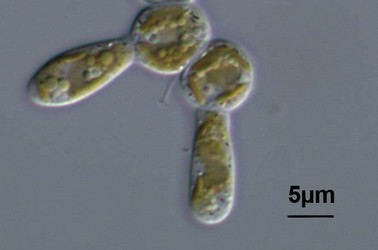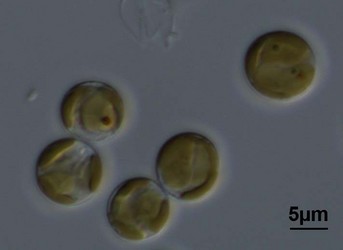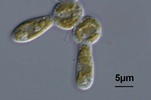Phaeothamniophyceae
J. Craig Bailey


This tree diagram shows the relationships between several groups of organisms.
The root of the current tree connects the organisms featured in this tree to their containing group and the rest of the Tree of Life. The basal branching point in the tree represents the ancestor of the other groups in the tree. This ancestor diversified over time into several descendent subgroups, which are represented as internal nodes and terminal taxa to the right.

You can click on the root to travel down the Tree of Life all the way to the root of all Life, and you can click on the names of descendent subgroups to travel up the Tree of Life all the way to individual species.
For more information on ToL tree formatting, please see Interpreting the Tree or Classification. To learn more about phylogenetic trees, please visit our Phylogenetic Biology pages.
close boxIntroduction
Included genera: Chrysapion, Chrysoclonium, Chrysodictyon, Phaeobotrys, Phaeogloea, Phaeoschizochlamys, Phaeothamnion, Sphaeridiothrix, Selenophaea, Stichogloea, Tetrachrysis, Tetrapion, Tetrasporopsis.
Characteristics
- Golden-brown colored photosynthetic eukaryotes that are filamentous, pseudofilamentous, coccoid or capsoid in nature. Most described from fresh or brackish waters.
- Mitochondria with tubular cristae.
- Plastids (2-4 per cell) with girdle lamellae and ring-shaped nucleoids. Pyrenoids sometimes present and, if so, immersed.
- Photosynthetic pigments include chlorophylls a and c, fucoxanthin, heteroxanthin, diadinoxanthin, diatoxanthin, and beta carotene.
- Cell walls usually appear to be of laminate (layered) construction.
- Electron dense and electron transparent vesicles of unknown composition are present at the cells’ periphery.
- Asexual reproduction by cell division, nonmotile autospores, or biflagellate zoospores. Sexual reproduction unknown.
- Reproductive cells are formed by eleutheroschisis, meaning that the daughter cells form entirely new cell walls inside the older mother cell wall.
- Zoospores with subapically to laterally inserted flagella; basal bodies forming an obtuse angle with respect to one another.
- Mastigonemes (flagellar hairs) lacking lateral filaments.
- Transitional helix present.
- Storage products (lipids, chrysolaminaran?), contractile vacuoles, and rhizoplast unknown.
Taxonomic History and Phylogeny
The Phaeothamniophyceae was established by Bailey et al. (1998) and includes organisms once classified in the Chrysophyceae or Xanthophyceae. At this time the class includes 13 genera and 26 specific or subspecific taxa (varieties). The class was originally erected based on ultrastructural and/or DNA sequence data for three principal taxa: Phaeoschizochlamys mucosa, Phaeothamnion confervicola, and Stichogloea doederleinii. Ultrastructural observations of Phaeobotrys and Tetrasporopsis have also been made. These three species form a monophyletic group that is not closely related to the chrysophytes or synurophytes. Instead, Phaeoschizochlamys, Phaeothamnion and Stichogloea are most closely related to photosynthetic stramenopiles placed in the classes Phaeophyceae and Xanthophyceae.
The remaining 10 genera assigned to the class have been placed in the class with uncertainty. Comparative data for these phaeothamniophytes is extraordinarily limited because they are not available in culture. In fact, most have not been mentioned in the literature since they were originally described.
Title Illustrations

| Scientific Name | Phaeothamnion confervicola |
|---|---|
| Specimen Condition | Live Specimen |
| Identified By | J.C. Bailey |
| Copyright |
© 2010 J. Craig Bailey

|
| Scientific Name | Stichogloea doederleinii |
|---|---|
| Specimen Condition | Live Specimen |
| Copyright |
© 2010 J. Craig Bailey

|
About This Page
J. Craig Bailey

University of North Carolina Wilmington, Wilmington, North Carolina, USA
Correspondence regarding this page should be directed to J. Craig Bailey at
baileyc@uncw.edu
Page copyright © 2010 J. Craig Bailey
All Rights Reserved.
- First online 24 January 2010
- Content changed 24 January 2010
Citing this page:
Bailey, J. Craig. 2010. Phaeothamniophyceae. Version 24 January 2010 (under construction). http://tolweb.org/Phaeothamniophyceae/141578/2010.01.24 in The Tree of Life Web Project, http://tolweb.org/









 Go to quick links
Go to quick search
Go to navigation for this section of the ToL site
Go to detailed links for the ToL site
Go to quick links
Go to quick search
Go to navigation for this section of the ToL site
Go to detailed links for the ToL site